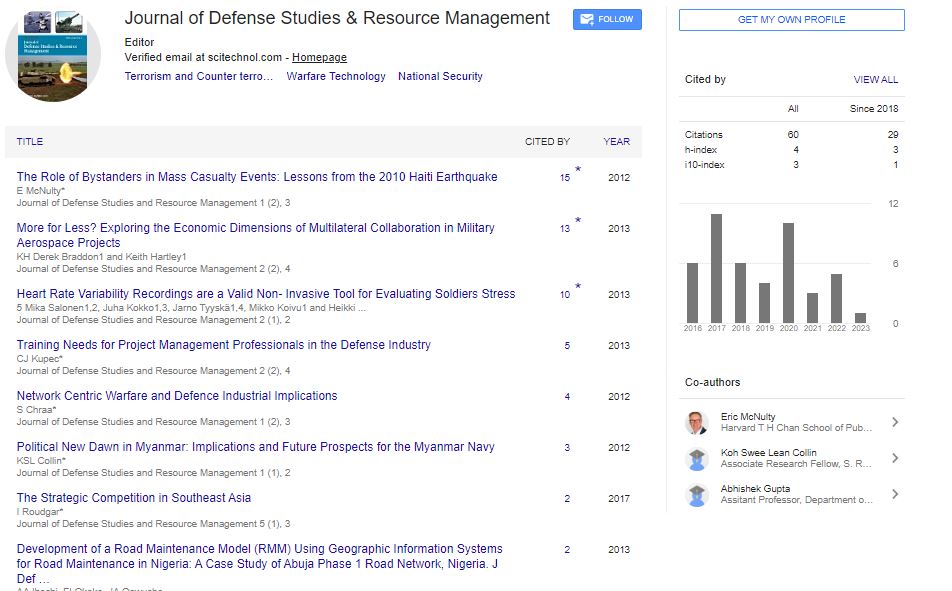Commentary, J Def Stud Resour Manage Vol: 11 Issue: 4
The History and Impact of Sierra Leone Civil War on Mankind
Daniel Wolgabearl*
1Department of International Relations, Lehigh University, Bethlehem, USA
*Corresponding Author: Daniel Wolgabearl,
Department of International
Relations, Lehigh University, Bethlehem, USA
E-mail: dwolgabearl@umd.edu
Received date: 30 October, 2023, Manuscript No. JDSRM-23-120624;
Editor assigned date: 01 November, 2023, PreQC No. JDSRM-23-120624 (PQ);
Reviewed date: 16 November, 2023, QC No. JDSRM-23-120624;
Revised date: 23 November, 2023, Manuscript No. JDSRM-23-120624 (R);
Published date: 30 November, 2023, DOI: 10.4172/ 2324-9315. 1000192
Citation: Wolgabearl D (2023) The History and Impact of Sierra Leone Civil War on Mankind. J Def Stud Resour Manage 11:4.
Abstract
The Sierra Leone Civil War, which ravaged the West African nation from 1991 to 2002, stands as a stark testament to the depths of human brutality and the transformative power of resilience and international intervention. This perspective article delves into the harrowing events of the Sierra Leone Civil War, explores its root causes, examines the international response, and reflects on the nation's remarkable journey from horror to hope.
Description
The Sierra Leone Civil War, which ravaged the West African nation from 1991 to 2002, stands as a stark testament to the depths of human brutality and the transformative power of resilience and international intervention. This perspective article delves into the harrowing events of the Sierra Leone Civil War, explores its root causes, examines the international response, and reflects on the nation's remarkable journey from horror to hope. The origins of the Sierra Leone Civil War are deeply rooted in a complex interplay of historical, political, and socioeconomic factors. The war was ignited by the Revolutionary United Front (RUF), a rebel group led by Foday Sankoh, who sought to overthrow the government and exploit the country's rich diamond resources.
Decades of social injustice and economic inequality fueled discontent, providing fertile ground for rebellion. The illicit trade in blood diamonds, used by the rebels to fund their insurgency, exacerbated the conflict and fueled atrocities. The oppressive rule of President Joseph Momoh created an environment ripe for rebellion, with widespread dissatisfaction among the population. The Sierra Leone Civil War was marked by unspeakable atrocities, including mutilations, mass killings, and the widespread recruitment of child soldiers. The RUF's brutal tactics, characterized by the hacking off of limbs and the terrorization of civilians, shocked the world and drew attention to the urgent need for international intervention. The recruitment of child soldiers, forced to commit unspeakable acts, became a haunting symbol of the war's brutality. The RUF systematically targeted civilians, committing widespread atrocities that left deep scars on the nation's psyche.
International response
The international community responded to the horrors of the Sierra Leone Civil War with a mixture of horror, outrage, and a determination to intervene. Several key factors shaped the international response. The United Nations Mission in Sierra Leone (UNAMSIL) played a pivotal role in stabilizing the situation, disarming combatants, and facilitating the return to peace. In 2000, British forces intervened in Operation Palliser, supporting UNAMSIL and effectively bringing an end to the war. The establishment of the Special Court for Sierra Leone aimed at prosecuting those responsible for war crimes and crimes against humanity.
Post-war Sierra Leone faced the colossal task of rebuilding shattered communities and fostering reconciliation. The nation's journey from horror to hope involved multifaceted efforts. The TRC sought to heal wounds by providing a platform for victims and perpetrators to share their stories and promote national reconciliation. Focused initiatives on economic development, poverty reduction, and equitable resource distribution aimed to address the root causes of the conflict. Investing in education became a cornerstone for building a resilient society, empowering future generations to break the cycle of violence. Timely international intervention is crucial in preventing the escalation of conflicts and mitigating human suffering. Establishing mechanisms for accountability and justice is essential for healing and preventing the recurrence of violence. Focused efforts on communitycentric recovery, including education and economic development, are integral to rebuilding societies torn apart by conflict.
Conclusion
The story of Sierra Leone's Civil War is one of horror and hope, of despair and resilience. While the scars of the conflict remain, the nation's remarkable journey towards stability and reconciliation serves as an inspiration. The lessons learned from Sierra Leone underscore the global imperative to prevent, intervene, and rebuild in the aftermath of internal conflicts, offering a glimmer of hope for other nations grappling with the ravages of civil war. Sierra Leone's narrative reminds us that even in the darkest times, the human spirit can prevail, paving the way for a future founded on peace, justice, and the collective resolve to learn from the mistakes of the past.
 Spanish
Spanish  Chinese
Chinese  Russian
Russian  German
German  French
French  Japanese
Japanese  Portuguese
Portuguese  Hindi
Hindi 